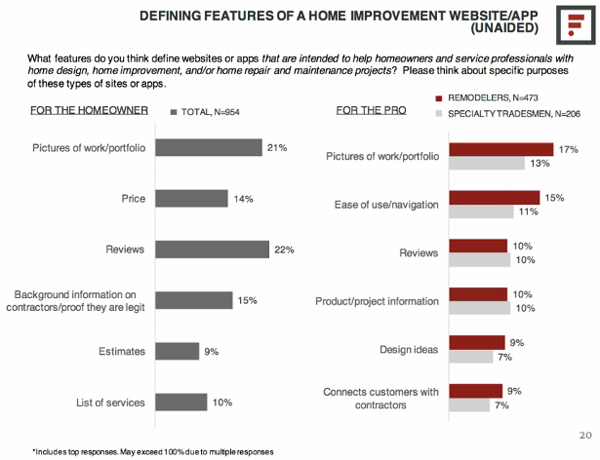What Customers Are Looking For On Your Website

With technology at our fingertips, it’s more important than ever to have a functioning website for your business. We know how important this is for contractors. Having a website can help generate leads and awareness of your services. But how do you know your website is functioning how your customer needs it to? By knowing what customers are looking for, you can better assist them to the information they need and get leads faster.

Contractor Wants vs. Customer Needs
In a recent study released by The Farnsworth Group, 20% of homeowners said they used a pro’s website to both find and contact them. Three out of 10 pros said they get 11% to 25% of their leads from their website or app-generated lead.
When it comes to needs, the study shows that pros and their potential customers have very different ideas of what makes a good website. For both parties however, photos and examples are believed to be the most important. Contractors want to show the good work they have done and homeowners are looking for examples to see if the pro has the ability to complete the project to their expectations.
Pros think website navigation, reviews and project information are top priorities for their viewer. Homeowners think differently however, as reviews and background information are key. They want to know that the pro they are considering for the job is legitimate and gather enough information from previous customers to make the right call.

Create A Website for Your Customer
If the potential customer can’t find what they need on your website, they’re likely to click away without contacting you. What can you do to make your website customer-friendly and relay the information you need? Here are a few ideas.
Provide Real Photos
From the data, we can see that both customers and pros have the same priority here. Pros want to show off the great work they have done and customers want to see it. People respond much better to visuals than anything else. However, skip the stock photos. Post photos that you have permission to use and photos that show the work you’ve done. Consider hiring a photographer to capture work you are really proud of and really impress potential customers.
Think About User Experience
You may not think your reviews are important, but your customer does. Make it easy and prominent for them to find on your website. If you have a negative review, don’t ignore it. Though the potential customer may see the review, how you handle the situation can speak louder than what was said. Respond back in a clear and professional manner, always providing excellent customer service.
Additionally, make sure photos and other customer priorities are easy to find. Don’t bury important information about your services.
Pay Attention to Content
It may seem trivial, but giving your website a check for grammar and spelling can be worth your while. Editing errors can make your website look unprofessional and turn off a potential customer. Your website can often be the first impression the customer has of your work. Don’t let a proofreading error get in the way of winning the job.
According to Hubspot, 55% of viewers spend less than 15 seconds on a website, at least before deciding they want to click away. Information on your page should catch their attention, but be concise so your visitors can gather what they need to know as quickly as possible.
If you include a contact form on your page, stick to information you absolutely need to know. This will likely be just their name, phone number and email. The more questions you require a response to, the less likely the user will complete the form.
Create A Responsive Website
Everything is mobile. If you want to be accessible to your customers, meet them where they are. A responsive website design makes sure your website looks good on any device used. The benefits not only help the user experience and site navigation, but it also helps customers find you through search.
Furthermore, you must use colors that will appeal to your customers. Pay attention to the color choices you’re using, making sure they complement each other and don’t clash. It’s easy for text to blend into the background if colors are too light or too dark. Check out a few color pallets that work at The Daily Egg.

Conclusion
Now that you understand what consumers are looking for, you can create a website to truly meet their needs and start getting more leads. Remember, what you think is important might not always be the same for the customer. Show the homeowner you understand their needs through a website that works.



